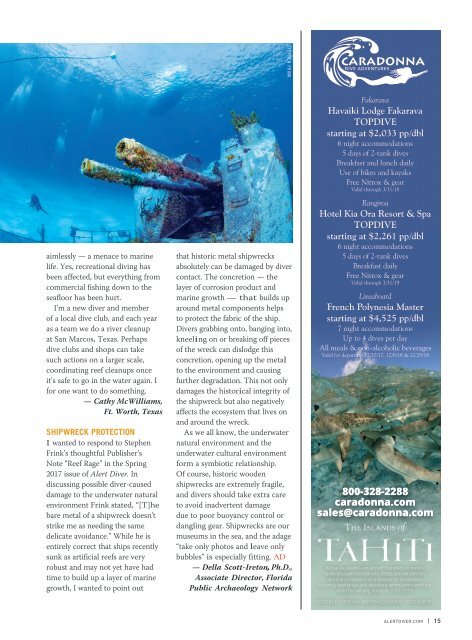AD 2017 Q4
Alert Diver is the dive industry’s leading publication. Featuring DAN’s core content of dive safety, research, education and medical information, each issue is a must-read reference, archived and shared by passionate scuba enthusiasts. In addition, Alert Diver showcases fascinating dive destinations and marine environmental topics through images from the world’s greatest underwater photographers and stories from the most experienced and eloquent dive journalists in the business.
Alert Diver is the dive industry’s leading publication. Featuring DAN’s core content of dive safety, research, education and medical information, each issue is a must-read reference, archived and shared by passionate scuba enthusiasts. In addition, Alert Diver showcases fascinating dive destinations and marine environmental topics through images from the world’s greatest underwater photographers and stories from the most experienced and eloquent dive journalists in the business.
You also want an ePaper? Increase the reach of your titles
YUMPU automatically turns print PDFs into web optimized ePapers that Google loves.
<strong>AD</strong>-Tahiti-Aug <strong>2017</strong>.pdf 1 9/7/<strong>2017</strong> 9:23:19 AM<br />
STEPHEN FRINK<br />
aimlessly — a menace to marine<br />
life. Yes, recreational diving has<br />
been affected, but everything from<br />
commercial fishing down to the<br />
seafloor has been hurt.<br />
I’m a new diver and member<br />
of a local dive club, and each year<br />
as a team we do a river cleanup<br />
at San Marcos, Texas. Perhaps<br />
dive clubs and shops can take<br />
such actions on a larger scale,<br />
coordinating reef cleanups once<br />
it’s safe to go in the water again. I<br />
for one want to do something.<br />
— Cathy McWilliams,<br />
Ft. Worth, Texas<br />
SHIPWRECK PROTECTION<br />
I wanted to respond to Stephen<br />
Frink’s thoughtful Publisher’s<br />
Note “Reef Rage” in the Spring<br />
<strong>2017</strong> issue of Alert Diver. In<br />
discussing possible diver-caused<br />
damage to the underwater natural<br />
environment Frink stated, “[T]he<br />
bare metal of a shipwreck doesn’t<br />
strike me as needing the same<br />
delicate avoidance.” While he is<br />
entirely correct that ships recently<br />
sunk as artificial reefs are very<br />
robust and may not yet have had<br />
time to build up a layer of marine<br />
growth, I wanted to point out<br />
that historic metal shipwrecks<br />
absolutely can be damaged by diver<br />
C<br />
contact. The concretion — the<br />
layer of corrosion product and<br />
marine growth — that builds up<br />
Y<br />
around metal components helps<br />
to protect the fabric of the ship.<br />
Divers grabbing onto, banging into,<br />
kneeling on or breaking off pieces<br />
of the wreck can dislodge this<br />
concretion, opening up the metal<br />
K<br />
to the environment and causing<br />
further degradation. This not only<br />
damages the historical integrity of<br />
the shipwreck but also negatively<br />
affects the ecosystem that lives on<br />
and around the wreck.<br />
As we all know, the underwater<br />
natural environment and the<br />
underwater cultural environment<br />
form a symbiotic relationship.<br />
Of course, historic wooden<br />
shipwrecks are extremely fragile,<br />
and divers should take extra care<br />
to avoid inadvertent damage<br />
due to poor buoyancy control or<br />
dangling gear. Shipwrecks are our<br />
museums in the sea, and the adage<br />
“take only photos and leave only<br />
bubbles” is especially fitting. <strong>AD</strong><br />
— Della Scott-Ireton, Ph.D.,<br />
Associate Director, Florida<br />
Public Archaeology Network<br />
M<br />
CM<br />
MY<br />
CY<br />
CMY<br />
Fakarava<br />
Havaiki Lodge Fakarava<br />
TOPDIVE<br />
starting at $2,033 pp/dbl<br />
6 night accommodations<br />
5 days of 2-tank dives<br />
Breakfast and lunch daily<br />
Use of bikes and kayaks<br />
Free Nitrox & gear<br />
Valid through 3/31/18<br />
Rangiroa<br />
Hotel Kia Ora Resort & Spa<br />
TOPDIVE<br />
starting at $2,261 pp/dbl<br />
6 night accommodations<br />
5 days of 2-tank dives<br />
Breakfast daily<br />
Free Nitrox & gear<br />
Valid through 3/31/19<br />
Liveaboard<br />
French Polynesia Master<br />
starting at $4,525 pp/dbl<br />
7 night accommodations<br />
Up to 4 dives per day<br />
All meals & non-alcoholic beverages<br />
Valid for departure 12/20/17, 12/8/18 & 12/29/18<br />
800-328-2288<br />
caradonna.com<br />
sales@caradonna.com<br />
All packages include airport transfers to hotels,<br />
taxes and service charges. Rates are per person,<br />
double occupancy and subject to availability,<br />
currency exchange and standard terms and condition.<br />
Valid for varying dates in <strong>2017</strong>-2019.<br />
CSOT#2111993-40 • WSOT#603254369 • FSOT#38781<br />
ALERTDIVER.COM | 15









